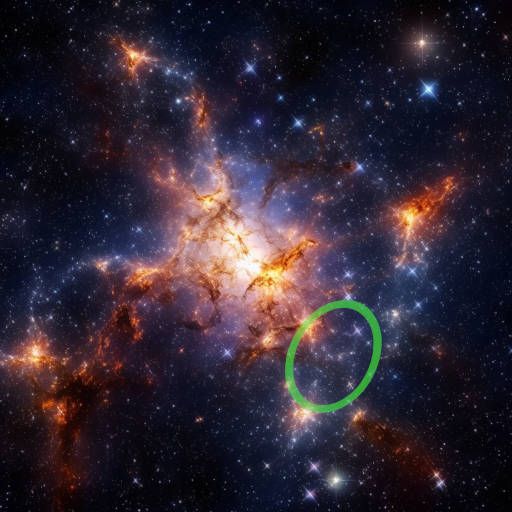Cusco, 6/6/38 T.A.D. – Dr. Javier Panteón, a recent Ph.D. graduate in astronomy from the prestigious National University of San Marcos in Peru, has made a startling discovery: a cluster of stars in the distant galaxy SDF-46975 appears to emit synchronized pulses of signals that, when converted and rendered as sound, contain unmistakable musical structure. He believes this may be evidence of a civilization with stellar-scale engineering capabilities–in other words, aliens who can build entire stars.
Located 13.1 billion light-years away, SDF-46975 is an incredibly dense galaxy without a common name. Panteón’s groundbreaking finding has ignited significant debate in the scientific community and captured the attention of the public at large.
To detect the unusual signals, Panteón utilized existing radio telescope data and developed a proprietary software suite called “Harmonic Horizons.” The software identifies cosmic signals, isolates their frequencies, and then processes them through a specially designed algorithm capable of discerning underlying musical patterns.
Despite his rigorous methodology and innovative technology, Panteón’s work has been widely dismissed by mainstream astronomers. Critics argue that the notion of constructing stars or manipulating their emissions is implausible. They claim the concept of non-directional ordered structure is flawed, saying that it’s like trying to decipher a sheet of music where all the notes are jumbled – there’s no clear way to determine the correct order in which to read them. Many also question whether extraterrestrial life could perceive sound in the same range as humans, or even possess the ability to hear at all. Finally, SDF-46975 is so distant that it is among the earliest detectable areas in the universe, meaning that most of the stars in it may not even exist, having finished their life cycles and extinguished their nuclear fires long ago.
Dr. Beatriz Ferreira, a senior astronomer at the European Southern Observatory, expressed her skepticism, saying, “The idea of aliens creating stars to play music is fascinating but incredibly unlikely. There are numerous alternative explanations for such signals, including natural phenomena.”
Panteón’s credibility has also been challenged, with some suggesting that he may have doctored the data. Consequently, no other researchers have attempted to replicate his findings, leaving Panteón without the validation he seeks.
However, the tide may be turning in Panteón’s favor. Dr. João de Oliveira, a highly respected and retired astrophysicist from Brazil, and former head of the International Space Agency, has recently expressed interest in Panteón’s work. His endorsement has come as a surprise to many in the academic and professional astronomy community.
In a recent interview, Dr. de Oliveira said, “While I understand the skepticism surrounding Dr. Panteón’s findings, I admire his innovative approach and dedication to uncovering the mysteries of the cosmos. I believe that continued research in this area may lead us to new discoveries and a deeper understanding of our universe. I ask my colleagues, did you actually read his paper? Did you listen to the music of the stars?”
Panteón, encouraged by Dr. de Oliveira’s support, remains steadfast in his pursuit of the truth behind these musical cosmic signals. He plans to continue refining his software, collaborate with other open-minded scientists, and explore the mysteries of the distant cluster.
Reporting for Future News, this is Alejandro Arizmendi in Cusco.
